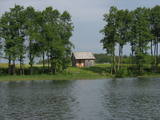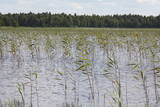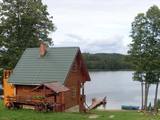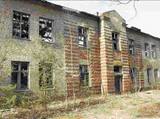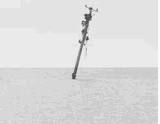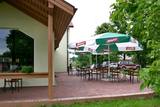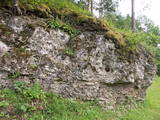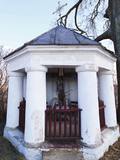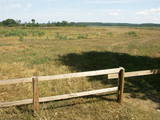| Nr | Name | Beschreibung |
|---|---|---|
|
Bis heute haben sich mehrere Häuser des Landgutes von Šlītere erhalten: Das Haus der Diener (Ende des 19. Jhs.), das Pumphaus (Mitte des 19. Jhs.), die Räucherei (Mitte des 19. Jhs.), der Stall u.a. Im Jahr 1936 wurde hier das Haus der Försterei (2010 restauriert) gebaut, in dem am Ende des Jahres 2009 die Verwaltung des Nationalparks Slītere aus Dundaga eingezogen hat. Heute heißt diese Verwaltung die Kurländische Regionalverwaltung der Naturschutzbehörde. Gegenüber dem Verwaltungsgebäude wachsen zwei Eibenbäume, aber die nördliche Seite des Dienerhauses bedeckt ein großer Efeu. Die gemeine Eibe und der baltische Efeu sind Symbole von Šlītere, die man hier an einem Ort besichtigen und fotografieren kann, ohne diese Pflanzen in ihrem natürlichen Lebensraum zu stören. Im Pumphaus hat sich aus den Zeiten des Landgutes ein auch im ganzen Lettland einzigartiger, 34 m tiefer Brunnen (genau so hoch sind die Blauen Berge von Šlītere!) erhalten, der bis in die 1970er Jahre benutzt worden und die Försterei mit Wasser versorgt haben soll. Heute kann man ein Fragment des gemauerten Schachtringes in der Pumphauswand besichtigen. Der Landgutkomplex wird von einigen Parkteilen mit einer eindrucksvollen Eschenallee eingeschlossen. In dem Gebäude der Försterei soll während seiner Jagdzeit der erste Präsident Lettlands Kārlis Ulmanis übernachtet haben. |
||
|
This is one of two crossing points across the Daugava (the other is near Līvāni). It is an exotic form of transportation to carry pedestrians, bicyclists and light automobiles across the river. There is a motor that operates a 200-metre metal cable. The crossing point is based on Soviet military pontoons that were used to build pontoon bridges for tanks. The crossing point was established by its owners. The Dunava Catholic Church is on the left bank of the river, and nearby is a monument to rafters. During the 1820s, there were three crossing points of this type across the Daugava. |
||
|
Tērvetes vīni ir ģimenes vīna darītava Tērvetē. Ražojam vīnu no pašu audzētām ogām un augļiem – avenēm, āboliem, ķiršiem, ērkšķogām, upenēm, cidonijām un no “īpašā dārzeņa” – rabarbera! 2019. gadā esam uzsākuši arī sava vīnogu dārza veidošanu un plānojam piedāvāt saviem viesiem vīnogu vīnu. Mēs - Dace un Sandris Laizāni, Tērvetes vīnu saimnieki esam kaislīgi “vīna mīļi” un šo mīlestību pret vīnu vēlamies nodot arī mūsu viesiem! Jums piedāvājam vīna darītavas apskati un vīnu degustāciju ar omulīgām sarunām par vīna tapšanu jaukā lauku ainavā Tērvetes upes krastā. Atkarībā no sezonas piedāvājam dažādu augļu un ogu vīnu, dzirkstošo vīnu un brendiju degustāciju. Saimniece Dace arī palutinās Jūs ar nelielām uzkodām - mājās ceptu maizi un pašas sietu sieru. |
||
|
Līčiem, pussalām un salām bagāts ezers ar izrobotu krasta līniju, kas savienots ar Zvejnieku un tālāk - citiem Latgales augstienes ezeriem. Ozolu un platlapju meži, kas aug uz ezera salām un pussalās ir ne tikai aizsargājami, bet arī Latvijas mērogā nozīmīgi biotopi. Tiesa, to vērtību apzināsies tikai vides speciālisti. No Jašas ezera var uzsākt laivu braucienu pa vienu no Latgales ezeru "kēdēm". Ezera austrumu krastā atrodas Geļenovas parks.
|
||
|
This is one of two sanatoriums in Jūrmala where mud from the surrounding area is used for medical procedures. The Jūrmala Spa Museum of History was opened here in 2009, and it offers interesting information about the history of the spa and the sanatorium. You will see historical photographs and medical equipment from the 1970s and 1980s. Guides will tell you all kinds of interesting information. |
||
|
There is picnic area and information stand at the end of the forest path leading from Muiznieki to Klanu Bog. Klanu Lake was formed in the place of Littorina marine lagoon. Nature restricted area was established to protect biotopes in the area of Klanu, Dziru and Stavu Lakes. There is wide information about the area available on the information stand.
|
||
|
Lauku māja atrodas Alksnis ezera krastā Aukštaitijas nacionālajā parkā. Ezers ir savienots ar pārējiem ezeriem, kas iekļaujas šinī parkā. Šī vieta ļoti piemērota makšķerniekiem un tiem, kuriem patīk baudīt mieru. Plaša viesistaba ar kamīnu, 2 guļamistabas, atsevišķs pirts namiņš, vieta ugunskuram, laivas nomai. |
||
|
On the second Saturday of each month, farmers, home manufacturers and craftspeople gather together to offer their products. You will always find tasty and useful things here. |
||
|
Das Gebiet der Meereswache mit einer Abteilung der Zenitraketen in Miķeļtornis wurde spezial für die Wache der Außengrenze der UdSSR gebildet. Zur Zeit wird in diesem Territorium nur das ehemalige Grenzwachegebiet genutzt, wo sich der Beobachtungsposten des Bataillons der Küstenwache befindet.
|
||
|
Cecīļu dabas taka ir kājāmgājēju tūrisma maršruts, kurā ir iespēja iepazīt Amatas novada dabas objektus gar Kumadas upes, Dančupītes un Amatas upes krastu. Takas sākuma punkts ir Amatas novada Ieriķos, 1 km no kafejnīcas, degvielas uzpildes stacijas, Cecīļu dabas takas apmeklētāju centra, blakus autoservisam. Apmeklētājiem ir iespēja izbaudīt cilvēka nepārveidotu dabas ainavu – Dančupītes kanjonu, minatūru ūdenskritumu, no Kumadas upes labā krasta aplūkot iespaidīgo Cecīļu iezi un citus objektus. Taka ir marķēta. |
||
|
Ja Rušona ezeru iepazīstiet ar laivu, tad var apmeklēt Lielo salu (ezera rietumdaļā),kur (augstākajā vietā) ir jāuzmeklē ap 1,2 m augstais akmens. Konstatēts, ka tā apkārtnē un uz virsmas kurināta uguns. Atrastas arī senlietas. Nostāsti vēsta, ka akmens virsmā bijušas iekaltas zīmes (nav saskatāmas) un pie tā upurēti jēri. Tikai nedodieties ezerā, ja ir vai gaidāms stiprs vējš! Rušona ezera salas ir dabas liegums. |
||
|
Schön, harmonisch und einzigartig, so wird der Hausgarten „Gundegos“ in der Gemeinde Daudzese beschrieben. Die Inhaberin Agrita Laizāne widmet dem Garten den größten Teil ihres Tages. Die meiste Arbeit gibt es indessen im Frühling, wenn sie von Inspiration getragen sät, pikiert, pflanzt, und im Herbst, bei der Ernte, bei dem Sammeln von Saatgut, dem Vorbereiten des Gartens auf den Winter und den Plänen fürs nächste Jahr. |
||
|
Farm is located ~1 km to the north of Puikule near to the former Limbazi railway, in the territory of North Vidzeme Biosphere Reserve. The farm breeds sheep of the Latvian dark-head breed from which wool, hats, scarves, souvenirs etc. are made by felting. They can be purchased in the farm. Sheep graze in nearby meadows, thus promoting plant diversity in the area. About the role of pets in maintaining biodiversity can also be read on the bench in the yard. In the barn house is a collection of household items. Visitors can take a guided tour and buy souvenirs. |
||
|
Ein gastfreundliches Café und eine Konditorei im Zentrum von Sigulda. Angeboten werden Salate, Suppen und andere warme Gerichte, Gebäck und Kuchen. |
||
|
Am Militärversuchsfeld des Flugwesens in Pape wurde früher Schießausbildung und Bombardierungen im Sturtzflug ausprobiert. Zur Zeit ist das Objekt im Besitz von der Selbstverwaltung des Gebietes und es wird nicht genutzt. Auf dem Meeresgrunde liegen versenkte Schiffe und andere Ziele.
|
||
|
Das Café befindet sich im Zentrum von Dundaga, im Gästehaus Krūziņi. Lettische Küche: Sauerkrautsuppe, graue Erbsen mit Sauermilch, gebratene Flunder oder gebratener Kabeljau, Sauersuppe mit Kartoffeln. Das besondere Gericht : Turm aus Quark oder eine Creme aus den Produkten der Molkerei von Dundaga. |
||
|
GiLine ir ģimenes uzņēmums, kurš ražo konfektes Konfelāde un sīrupus. Konfelāde ir sulas konfektes, kas ražotas no Latvijā iegūtām augļu un ogu 100 % sulām, neizmantojot konservantus un garšas pastiprinātājus. Ražošanas procesā tiek izmantots roku darbs. Arī sīrupā izmantotas tikai dabīgas izejvielas. Piedāvā radošās ekskursijas ražotnē. |
||
|
Das ist ein Abschnitt des Gauja – Flusses mit Stromschnellen an einigen Stellen. Es erstreckt sich von Vidaga bis zum Ort, wo der Fluss Vecpalsa indie Gauja fließt. Entlang der Gauja und seinen Nebenflüssen kann man Dolomitaufschlüsse an seinen Ufern sehen, die größten sind die Randati – Klippen. Das Territorium wurde vor allem eingerichtet, um die verschiedenen Arten an Wald, Wiesen, Aufschlüssen und ihre Habitate zu schützen. Das ist ein interessanter Abschnitt des zentralen Teils der Gauja, vor allem für Leute, die die schöne Landschaft genießen möchten und für Wassertouristen.
|
||
|
The Crucifix of Kurpinīki is known also as the place where Janis Streičs
shot some scenes of the movie „The Child of a Man”. Long time ago this crucifix
was situated in the courtyard of writer’s grandfather Donat Klidzejs in the USA.
|
||
|
Regelmäßig werden die Auenwiesen am Ost- und Südufer des Sees Burtnieks überflutet, sie sind ein wichtiger Nistplatz für den selten gesehenen Wachtelkönig. Ein Natur- und Informationspfad wurde in Vīsrag eingerichtet mit Richtungsangaben, Informationsständen und einem Aussichtsturm.
|
||




